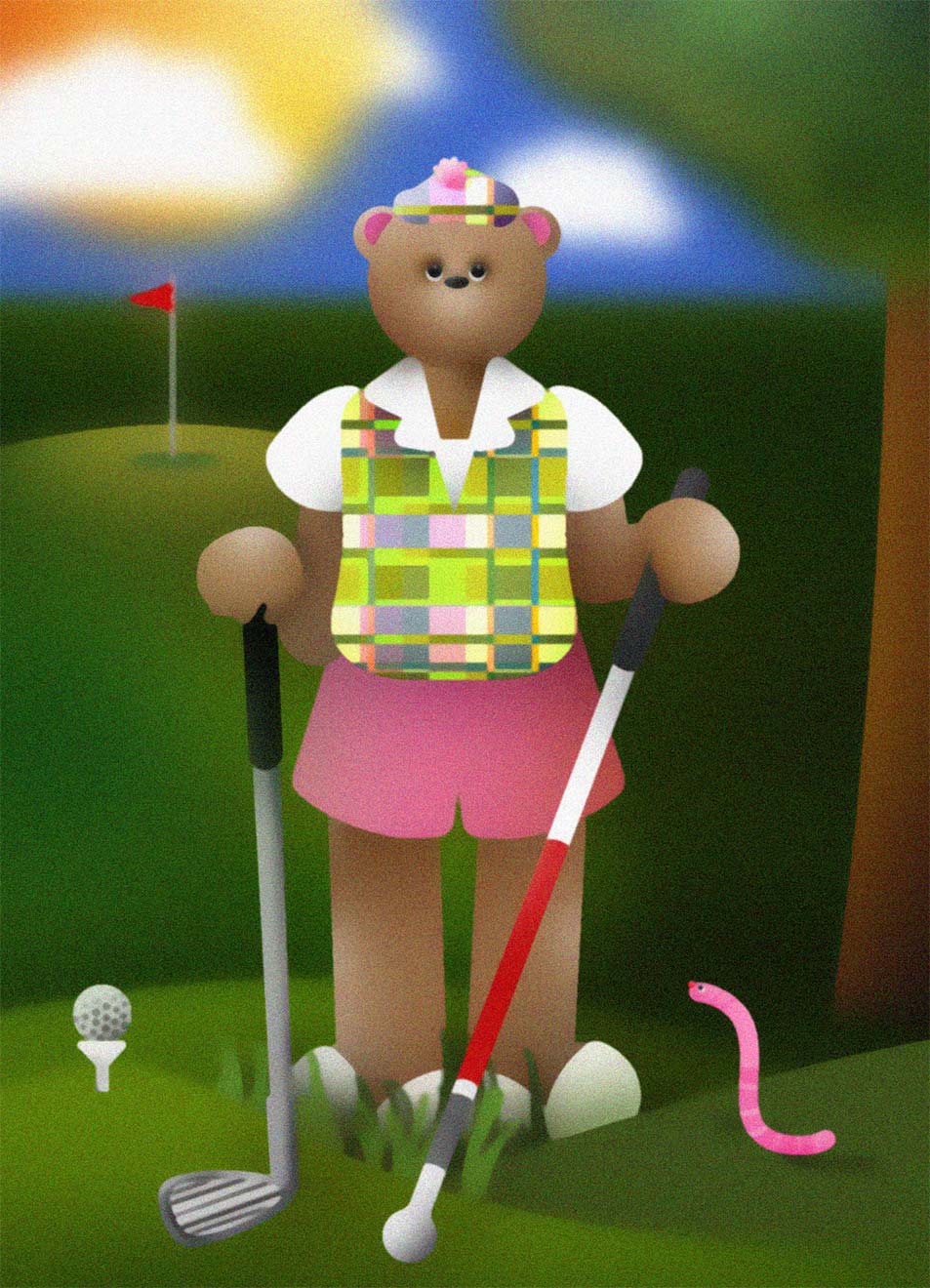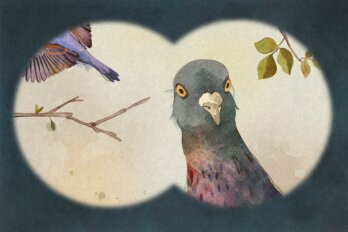On a warm evening last June, I unintentionally became a caricature that I typically mock: a legally blind golfer who hit a hole-in-one. My swing was, by no means, an athletic feat. I was taking part in a round of mini-putt in Ottawa with some friends. I knew my ball had landed in the hole when I heard my friends cheer. I laughed and quipped about my achievement. I couldn’t ignore the irony: I don’t particularly like golf, but every few years or so, someone tells me about a legally blind golfer’s lucky shot—as if they think a common disability will make me forget my indifference toward the sport. It’s strange to see which accomplishments are considered noteworthy when there are many things disabled people do every day, often with significant barriers.
On June 22—the day after my fluke golf swing—the Canada Disability Benefit Act became law. It allows the government to create a federal benefit with the stated intent “to reduce poverty and support the financial security of working-age Canadians with disabilities.” Details of the benefit, including who will be eligible for it and how much they will receive, will be worked out in regulations. It’s expected those regulations won’t be finalized until June 2025.
It may seem strange for politicians and policy wonks to be debating the first question—essentially, who is disabled? But the answer’s complicated. That’s not just because there are myriad disabilities and the same diagnosis impacts different people in different ways. It’s also because the same disability can mean multiple things to one individual and, at times, multiple things in the same moment.
On the mini-putt course, I outwardly treated my disability as a joke, a literal handicap to make a rare athletic success shine brighter. But inwardly, I spent much of the game hoping I wouldn’t slow everyone down. My reaction to Bill C-22’s passing had a similar duality. As a journalist who had reported on the benefit since September 2020, I was glad to see this part of the benefit’s creation be complete. But that was tempered by a sobering reality: while government programs to help disabled people are often called “benefits,” governments—and society—don’t treat disability as an asset. Disability puts you at a disadvantage automatically, often because of the way government programs are structured. And there’s no lucky swing that can guarantee success.
The federal Accessible Canada Act, which passed in 2019 with the goal of making the country accessible in key areas by 2040, defines disability as an impairment or functional limitation that, “in interaction with a barrier, hinders a person’s full and equal participation in society.” This approach is often called the social model of disability. It says disability is caused by society’s failures to create a world where disabled people have equal access to the same opportunities as non-disabled people do. By contrast, medical models of disability often focus on fixing the individual, usually through cures or making the disabled person “normal.” In my case, the medical model would say the solution for my disability is perfect vision; the social model would say the solution is found in larger font sizes, for example, or better lighting in public places.
The medical-model-versus-social-model debate isn’t straightforward. Sure, brighter lighting helps me. But people with other types of visual impairments benefit from dimmer lights; we may have the same disability but we require different things to fully participate in society.
Recently, some scholars and advocates have called for the recognition of what they call disability culture. The month of July is now celebrated as disability pride month.
Advocates are asking governments to incorporate cultural understandings of disability into their laws. Nova Scotia passed its accessibility law in 2017; the first independent review of it was released in May 2023. Led by Katie Aubrecht, a professor at St. Francis Xavier University and Canada research chair in health equity and social justice, the review calls on that province’s government to change various definitions in the law “to reflect awareness of disability as a fluid and evolving concept and a cultural identity.”
If disabled people are a cultural group, I can’t say it’s always the most hospitable culture—even for people deemed disabled by social and medical understandings of the term. For much of my life, I felt just as ostracized by my disabled peers as I did by those who didn’t have disabilities. And I learned quickly that social acceptance among disabled people required more than a doctor’s diagnosis.
In the early 1990s, when I began school, blind or visually impaired children across Canada still regularly attended W. Ross Macdonald School for the Blind in Brantford, Ontario. That option was not available to me, even though my family moved to Brantford for my father’s job when I was seven. As my parents have explained it, I had too much sight to qualify. And I don’t think they were ever keen for me to attend a different school, just because of a visual impairment, than the one my siblings went to. Throughout my education, supports were sparse and often informal.
Then, one summer during elementary school, my mother enrolled me in a day camp for kids with visual impairments. The programming allowed me to go to places my parents likely couldn’t afford. We travelled to Niagara Falls and Canada’s Wonderland. We camped. We swam at the local pool. A lot. It was everything a kid could want.
But I had rarely felt so out of place. I was blind enough to attend camp but not to fit in with all the other campers, most of whom, as I remember, attended W. Ross Macdonald School. It was hard to find a common blindness experience we shared. I didn’t have a white cane; I’d never been taught Braille. We once took public transit and the leaders told us to get our CNIB cards out, pieces of ID that showed we were registered with the Canadian National Institute of the Blind. I didn’t even know those cards existed (or how a card declaring “I can’t see” could be useful). Even though I became camp friends with some of the other girls, I felt uneasy around the whole group. The feeling I got from some of the other campers was clear: I was not blind enough.
But at the week-long overnight summer camp I attended, I needed help with the crafts and struggled to participate in group games. I loved camp, but I knew I would spend soccer games talking to spectators instead of actually playing. There, I wasn’t sighted enough.
This precarious position became a lifelong reality. I did finally get a white cane a few months before my sixteenth birthday. While my friends took driving lessons, my parents signed me up for orientation and mobility sessions, where a (very kind) CNIB instructor showed me how to use my cane properly when crossing the street and taught me self-advocacy skills, like calmly and clearly asking for directions.
My cane is a shorter, collapsible one called an identification cane; when folded, it fits easily into my purse. But I don’t always use it. During my undergraduate studies at Wilfrid Laurier University’s Brantford campus, I used my cane so inconsistently that people who saw me walking to class—one day with a cane, the next without one—would ask whether my vision had changed. Unbeknownst to me, my decisions about whether or not to pull out my cane were regularly discussed by passersby.
Such curiosity isn’t always harmless. When I lived in Toronto, people regularly grabbed my arm while on transit, wanting to guide me without knowing where I was going or—most importantly—receiving permission to do so. My disability allows me to sit in preferred seats on buses and subways; it also invites unsolicited advice about how going to the gym or avoiding white bread can heal my eyes, or enduring comments about how others can only imagine how difficult it must be to go through whatever it is they think I’m going through.
When I work with colleagues who also have visual impairments or are blind, my childhood insecurity resurfaces. I usually type with the font size at anywhere between fourteen and twenty-two, which is lower than what some others need; the magnification on the computer program I use is automatically set to four times—far from its maximum of sixty times. As a result, I’ve heard comments about my eyes not being that bad. I never know what to say, partly because I can’t see the speakers’ facial expressions well enough to determine their mood.
Strangers, relatives, and friends regularly ask me what I can and cannot see. I can’t answer these queries, largely because I don’t have any other point of reference. So when a stranger or a friend kindly offers assistance, even when I don’t need it, I sometimes accept. I bite back cynical thoughts about people just wanting to do good deeds. It’s easier than refusing help and then raising questions about what I can and cannot see all over again.
One characteristic of disability has become nearly universal in Canada: poverty. That is, after all, why this new federal benefit has been promised. According to Statistics Canada, in 2017, 28 percent of Canadians between the ages of twenty-five and sixty-four who had a severe disability lived in poverty; the proportion fell to 14 percent for those with mild disabilities and 10 percent for those with no disability at all.
Meaningful employment often eludes disabled Canadians. There are signs of improvement. The 2022 Canadian Survey on Disability reported that 62 percent of disabled Canadians between the ages of twenty-five and sixty-four were employed. That’s an increase of three percentage points from the 2017 survey. When they do find work, recent data suggests, they’ll still be at an economic disadvantage. Data from the 2019 Canada Income Survey showed that, on average, disabled Canadians earned 21.4 percent less than non-disabled Canadian workers. The income gap was greatest for those with cognitive disabilities, who earned less than half of what those without disabilities earned annually.
People with physical disabilities face considerable challenges too. Research from vision loss support organizations has found that Canadian adults who have a visual impairment or blindness—people like me—are at least twice as likely as the general population to be unemployed.
I started to understand the financial ramifications of being disabled when I approached my eighteenth birthday and began the application process for the Ontario Disability Support Program, the provincial social assistance program for disabled adults. My parents had received social assistance for me when I was a child. Now I needed to re-apply to show I was eligible for the adult benefits.
Many disabled adults rely on some form of social assistance to survive, though the amounts vary by province. The amounts are meagre: a July 2023 report from the Maytree Foundation, an anti-poverty organization, showed that, in 2022, the highest annual income for a single adult with a disability who relied on provincial social assistance was just over $20,000.
It doesn’t get much easier for people who work and also receive social assistance. Disability social assistance may decrease significantly when recipients report earned income. Some people find that working isn’t financially worth it, even though social assistance rates keep them impoverished.
When I applied, I was months away from starting university. My goal was pretty normal: I just wanted a job, and I assumed I would get one. My mother and the government employee both said they wanted me to get a job too but it might be harder for me. So, in case it was, I needed this program.
The very concept baffled me. I stared in disbelief at the kind government employee who told me that my liquid assets could not surpass $5,000, or I’d lose eligibility. (A few years ago, ODSP raised that limit to $40,000.) I needed medical assessments to confirm that my eyes would not be magically cured when the clock struck midnight on my birthday. I filled out a self-assessment form describing the limitations caused by my disability. This step was voluntary, but it was my opportunity to tell the government what living in my body was like, in the hopes I’d be deemed disabled enough.
The examples provided on the form didn’t help: they all seemed to describe adults who had acquired a disability that inhibited their work. My parents had stressed my independence and worked hard to minimize the negative impacts of my disability. It wasn’t easy to come up with significant limitations I faced, aside from my inability to drive.
Exasperated, I asked my dad if the government just wanted me to tell a sob story to convince them I needed money.
He said yes.
My application was approved.
I paid for much of my undergraduate tuition by working at a summer camp for people with disabilities. The social realities of disability were unavoidable. Most of the campers were adults—and many had spent their entire lives relying on social assistance. I was glimpsing my potential future. I didn’t like it.
It’s tempting to view the passing of the Canada Disability Benefit Act as a victory, a milestone moment for this country’s disability rights movement. The government wants to tell that narrative, describing the act’s passage as “landmark” and “groundbreaking” in a press release. Elsewhere, the celebration has been tempered with calls for the government to ensure that receiving the federal benefit won’t lessen other disability supports a person may get. Some also worry about how long it may take to create the benefit.
The caution is warranted. Within weeks of the law’s passing, two petitions were circulated that demanded the federal government create an emergency benefit for disabled Canadians until the new one becomes available; a more recent petition asks that those who are eligible receive back pay for the time between the law receiving royal assent and people receiving the benefit. The government, responding to the earlier, has so far refused to create an emergency benefit.
This benefit exists because of previous government failures. When it was first promised, in September 2020, many disabled Canadians were still waiting for the $600 one-time federal benefit that those who met specific eligibility criteria received during the COVID-19 pandemic. Compared to monthly $2,000 Canada Emergency Response Benefit payments, the amount added insult to injury.
At the time, the government was also working to expand access to medical assistance in dying to sick and disabled Canadians whose deaths aren’t naturally foreseeable. Legislation to do so was first introduced in February 2020. The majority of disabled Canadians decried the change, which became legal in March 2021, several months before legislation to create the disability benefit was introduced. In other words, the government was quicker to grant disabled Canadians access to assisted death than to introduce legislation to make their lives easier.
The specifics of the benefit may take years to work out, even after the initial regulations come into force. Throughout the legislative process, disability advocates were clear that they expected to be involved in creating the benefit—and they secured amendments that require the government to report on how they are consulted during the benefit’s creation. We should expect nothing less from disabled Canadians. This fight is theirs, and they won’t give up easily.
But having to constantly negotiate what it means to be disabled, and then to fight for the services you need if you are, is exhausting. I’ve found that constantly jumping through hoops to receive government benefits, many of which I know will fall short, has also led me to doubt myself. When people tell me I’m a good writer, I often imagine them adding for a blind girl, as if my work is automatically expected to be inferior. I assume they think less of me—even when they’ve given no indication that they do.
Early on during the summer before starting university, my first time working at the camp for disabled people, I met a young girl who reminded me of myself at twelve or thirteen, an age when I was becoming aware that neither sighted nor visually impaired peers fully understood how to interact with me. She had come to camp for a week that was designated for youth programming. I tried to spend as much time with her as I could. At the dance at the end of the week, I asked if she wanted to join me for some songs.
I banged into nearly every chair that we had pushed aside to make a dance floor. Over the speakers, Shania Twain crooned, “Can only go up from here,” while I apologized repeatedly for my awkwardness, for the furniture I could never miss.
But I don’t know if my camper heard me. She was laughing too hard to worry about bruises.





